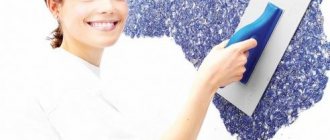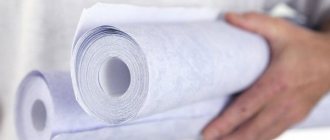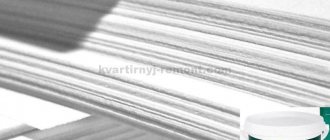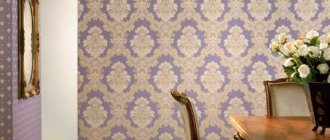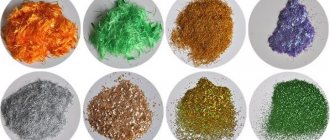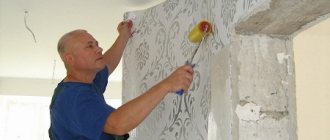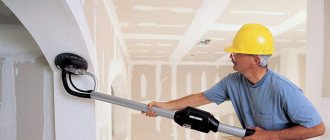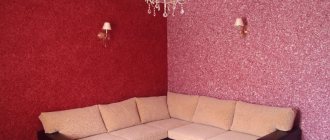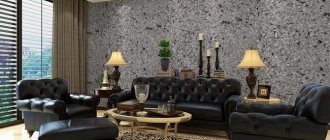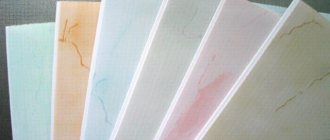Various coating options are used to decorate rooms and building facades. Now in construction stores you can find a wide range of materials that are used in repair and finishing work. If desired, you can choose the appropriate option to create a unique design in the room.
One of the most popular ways to decorate walls is liquid wallpaper. Often applied to drywall. The presented material has good wear resistance, is easy to apply to walls, and is suitable for almost all types of coatings. The composition looks beautiful on wood, concrete and other types of bases.
Is it possible to apply liquid wallpaper to drywall?
Many users online, before carrying out repair work using liquid wallpaper, ask whether they can be applied to drywall.
The main reason for doubt is the name of the material. However, do not worry, liquid wallpaper will not harm the plasterboard coating, since the amount of water in the material is not enough to deform the base.
Initially, the material is a dry mixture, which should be diluted with water in the ratio established by the manufacturers. The mixture contains paper, silk and cotton fibers, glue, and decorative elements. After adding water, the solution acquires a dough-like consistency. Applying liquid wallpaper to drywall will allow you to create a unique design in your home, while the slightly damp solution will not damage the base of the partitions.
Features of drywall
The plasterboard version of the walls has a number of distinctive features, among which manufacturers note the following:
- Plasterboard walls are highly durable and resistant to external mechanical influences;
- GKL have fire-resistant properties, which is extremely important for compliance with fire safety regulations;
- The presented option is made from environmentally friendly materials that do not emit toxic compounds;
- Has good thermal insulation and suppression of sound waves;
- The coating does not leave an unpleasant odor in the room;
- Using this option allows you to create decorative coatings of any complexity; you can often find a ceiling made of plasterboard;
- The material is susceptible to moisture absorption, but this does not prevent the use of liquid wallpaper as a coating;
- Relatively low cost of material.
Tools for work
Prepare in advance all the necessary tools for applying liquid wallpaper. You may need:
- Plastic trowel, 3-4 mm thick pile roller or spray. Choose one thing from the list.
- Large spatula.
- Ironing iron.
- Notched spatula, paper tape or sickle tape (if there are seams on the wall).
- A large container in which you can dilute dry powder.
- Putty and deep penetration primer or white paint.
- Gloves. The composition of the powder is not hazardous to health, but for convenience you can mix it with gloves.
Preparing the plasterboard base
Before performing the main stage of work, you should carefully prepare the walls from gypsum plasterboard. Preparation of drywall for liquid wallpaper is carried out in several stages. In this case, you should carefully process the walls, seal all the seams and depressions on the base, treat the walls with a primer, and create a smooth and even surface. To complete the preparatory work, it is worth carefully considering each of the stages.
Self-tapping screws go deeper into drywall
Processing of metal screws
Particular attention should be paid to the processing of metal structural elements.
If you glue liquid wallpaper over metal parts, over time moisture will get on the metal, and rust spots will appear on the surface.
In this regard, it is recommended to do the following:
- Nails and screws should be driven deep into the surface of the drywall.
- The heads of nails, screws and steel staples should be primed and then painted to prevent corrosion.
- It is additionally recommended to cover the surface of metal elements with a layer of putty.
- After this, you can begin the main stage of work.
Sealing joints, seams, holes
Any walls made of gypsum plasterboard have recesses, joints and seams. To glue liquid wallpaper onto drywall, you need to eliminate these irregularities on the wall. For this, putty is used, it is applied to a surface previously treated with a primer. The mixture is used to fill holes, recesses, joints and seams in the wall. This allows you to further distribute the composition evenly over the entire surface of the wall.
In difficult areas, you can make cuts 2-3 mm wide, and then fill them with reinforcing mesh to distribute the putty evenly. Additionally, you should putty the places where screws and other fixing elements are attached.
Drywall joints are reinforced with reinforced mesh
Do I need to putty completely?
You can apply liquid wallpaper to drywall without putty; professional builders and designers note that the quality of the coating will not suffer from this. However, if you wish, you can use putty to level the surface. It is also recommended to putty the wall if it has strong unevenness and changes in angle of inclination. Putty will not only level the surface, but will also give the base the same shade over the entire surface, which will allow you to create a monochromatic decorative coating.
To ensure that the color of the liquid wallpaper lies evenly, the drywall is completely puttied
So is it possible or not?
Don't think that this wallpaper is as liquid as water. In fact, when finished, they have a rather dense structure, reminiscent of putty or plaster in consistency. Wallpaper is made from a mixture of cellulose, glue, decorative elements (for example, glitter, shaped particles), cotton fibers, silk or other textiles. Dry ingredients are mixed with water (the proportion is indicated in the instructions). Then the mixture is infused and a fairly thick solution is obtained, which can be applied to walls made of any material.
Liquid wallpaper does not contain very much water. This amount of liquid will not harm the material of the partition. Therefore, you should not be afraid that the drywall will swell, change shape, etc. By the way, if this material is properly prepared, then it will not be afraid of large volumes of water.
Which primer to choose
Almost any primer with a moisture-proof effect is suitable for preparatory work. The main purpose of the primer is to increase adhesion to the base. If desired, you can use Silk Plaster material; it has excellent quality and good moisture-proof properties. When choosing a primer, you should focus on the country of manufacture, the characteristics of the material, as well as the price range.
The primer is applied in 2-3 layers
How to apply liquid wallpaper on drywall
With proper preparatory treatment of the walls, applying the material should not cause difficulties. To decorate the surface in a room, just prepare the solution and then carefully apply it to the wall. Professionals believe that liquid wallpaper is the best choice for beginners who want to change the design in their home. Ease of application and ease of use allow liquid wallpaper to occupy a leading position in the ranking of decorative materials.
Preparation of the solution
The first stage in decorating walls is preparing the mortar for work. To do this, you should read the instructions on the package with the dry mixture; usually manufacturers indicate the ratio in which the solution must be mixed:
- To work, you will need a wide basin or a deep bucket of 7-10 liters. The contents of the package must be completely poured into the container.
- Warm water should be added to the basin (the optimal temperature is 35-40°C).
- The resulting composition should be stirred with your hands to remove lumps. You should wear rubber gloves on your hands to prevent the mixture from sticking to your skin. Kneading should not be done with a mixer, as this will destroy the fibers and disrupt the structure of the material.
- After this, the remaining amount of water should be added to the container to give the solution a suitable consistency.
The solution should be prepared in advance, since it needs to sit for about 6-12 hours before application.
The finished mixture can be applied immediately, but if necessary, it can be left for 3-5 days in a sealed package, during which time it will not lose its properties.
Applying liquid wallpaper to drywall
After preparing the solution, you can proceed directly to decorating the walls in the house. When decorating, you should follow the simple rules below:
- To perform the work, you need to purchase a trowel and a construction trowel.
- The solution must be of a suitable consistency, since a material that is too liquid or too thick will not allow the wall to be adequately covered.
- The mixture should be applied in a progressive motion from corner to corner, since the circular distribution of the solution will lead to the formation of lumps.
- The layer should be approximately 1-2 mm thick; when applying a mixture of greater thickness, the material consumption will increase.
- The wall has joints, so you should use a special tool to work in the corners.
- It is recommended to decorate the surface in one go to avoid the formation of joints between different layers.
- To limit the area where the mixture is applied, you can use masking tape.
Compliance with the presented rules will allow even a beginner to carry out finishing work in the house, as well as create a bright and unique image in the room.
Features of liquid wallpaper
After drying, the wallpaper becomes soft, even silky. However, an interesting design effect is not the only advantage of this finishing material. The advantages of liquid wallpaper include:
- absence of joints, overlaps and other types of seams on the finished coating;
- ease of repair of any damage (it is enough to dilute a small amount of dry mixture and cover up the dirt or scratch);
- unlimited scope for flight of imagination, with the help of this wallpaper you can create complex designs;
- environmental friendliness - they contain only natural ingredients;
- ease of application;
- leveling of surface irregularities and defects;
- long service life - up to 10 years.
USEFUL INFORMATION: Installing a profile under drywall: doing the work yourself
Of course, they also have a number of disadvantages:
- easily absorb odors;
- don't wash;
- contaminants easily penetrate into the structure of the material;
- the effect of water on dried wallpaper can be destructive;
- upon contact with furniture and other objects, they can quickly wear out at the points of contact.
Video
If you want to carry out high-quality finishing work or repairs, you should watch a training video that describes all the stages in detail. Using video materials, you can study in detail the process of decorating walls. In addition, professional workers in the field of construction and renovation will share their experience and also give some useful tips when decorating rooms.
Tyutyunnikov Dmitry
Article verified by a decorative finishing specialist
